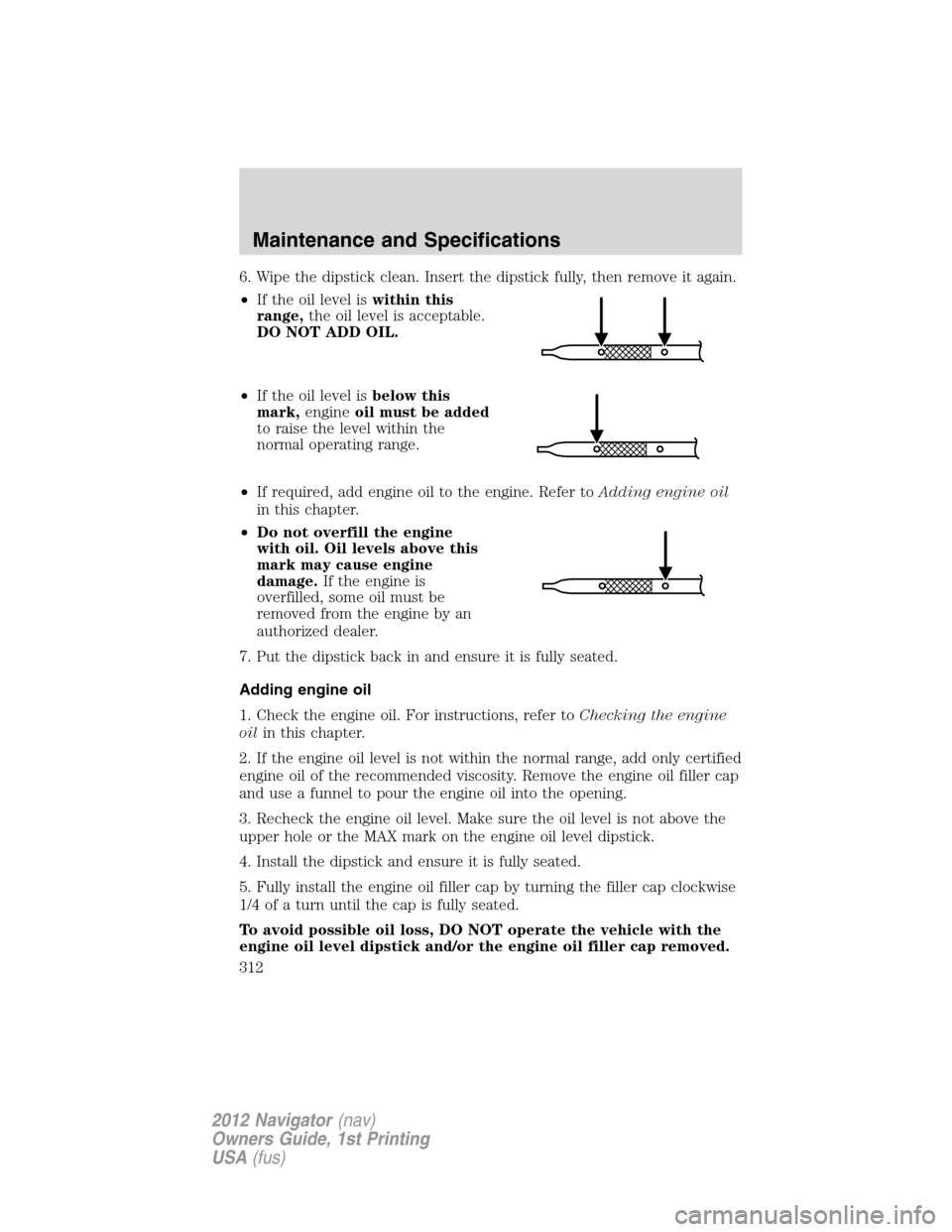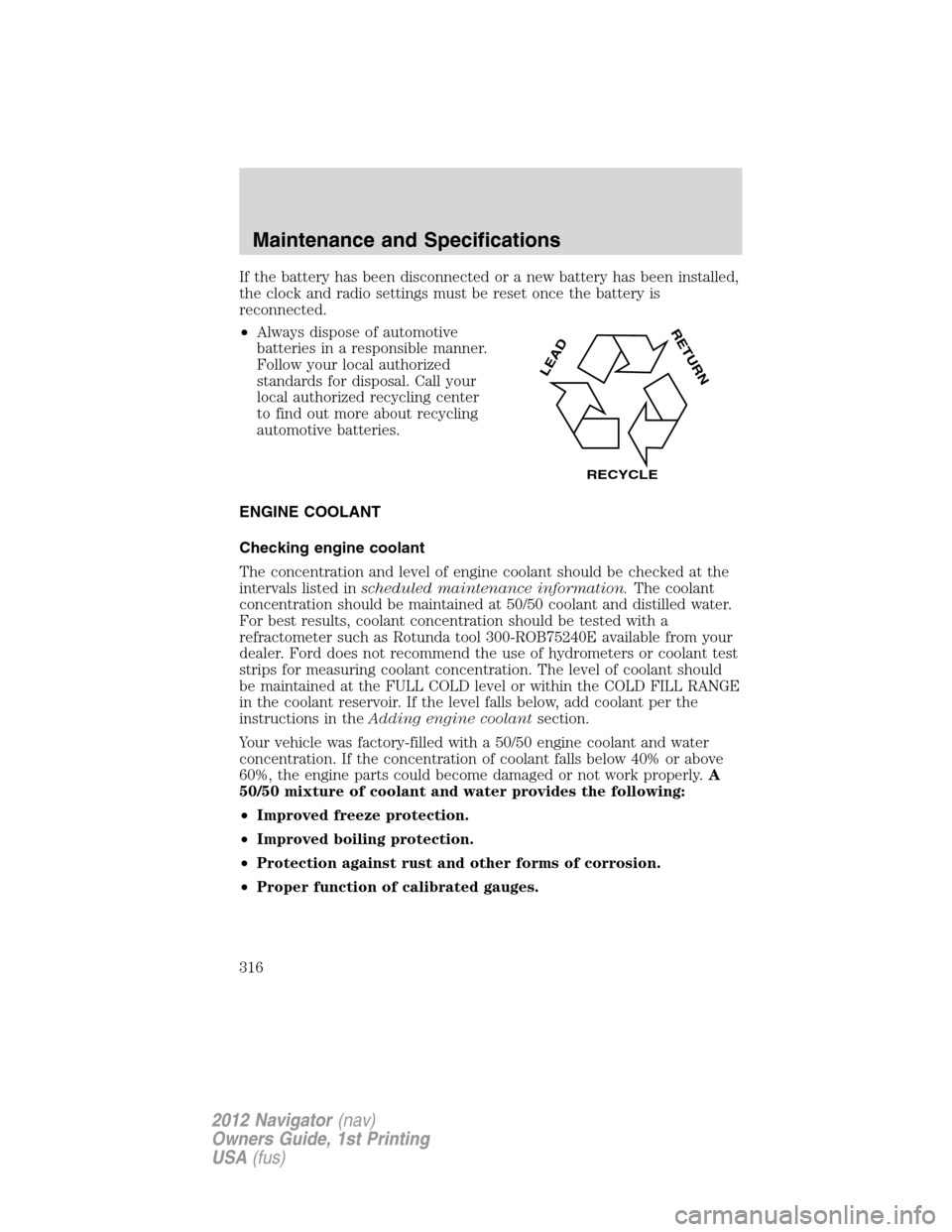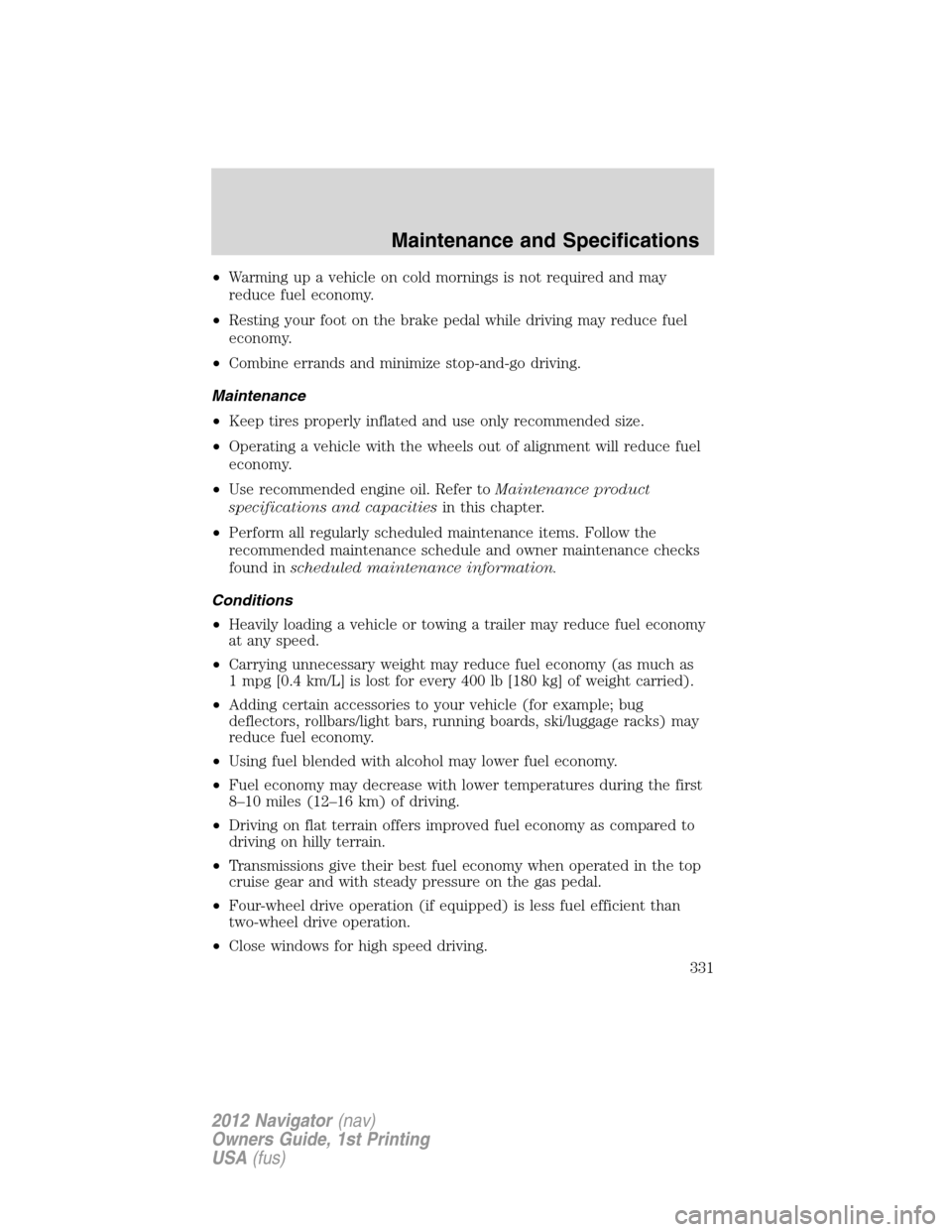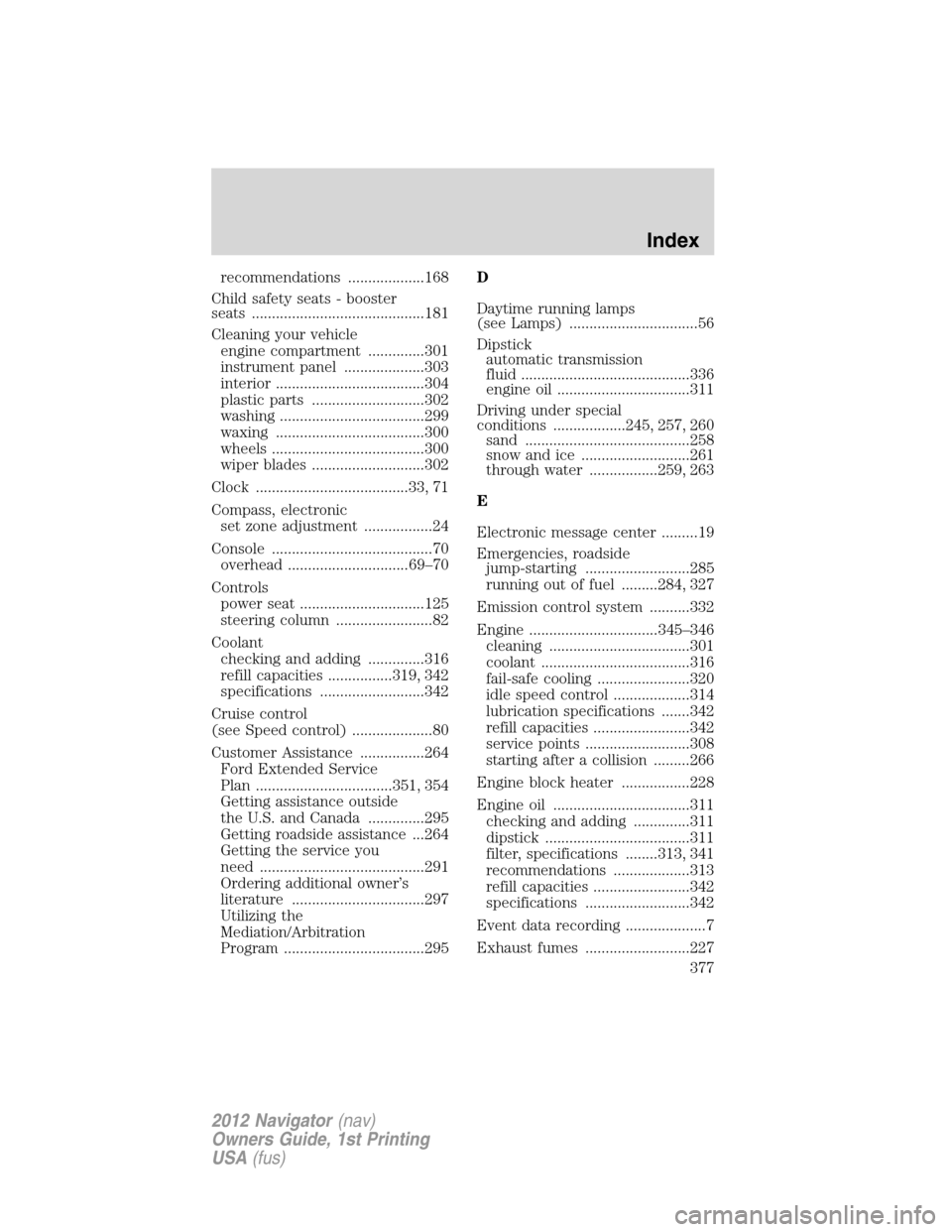adding oil LINCOLN NAVIGATOR 2012 Navigation Manual
[x] Cancel search | Manufacturer: LINCOLN, Model Year: 2012, Model line: NAVIGATOR, Model: LINCOLN NAVIGATOR 2012Pages: 381, PDF Size: 2.53 MB
Page 312 of 381

6. Wipe the dipstick clean. Insert the dipstick fully, then remove it again.
•If the oil level iswithin this
range,the oil level is acceptable.
DO NOT ADD OIL.
•If the oil level isbelow this
mark,engineoil must be added
to raise the level within the
normal operating range.
•If required, add engine oil to the engine. Refer toAdding engine oil
in this chapter.
•Do not overfill the engine
with oil. Oil levels above this
mark may cause engine
damage.If the engine is
overfilled, some oil must be
removed from the engine by an
authorized dealer.
7. Put the dipstick back in and ensure it is fully seated.
Adding engine oil
1. Check the engine oil. For instructions, refer toChecking the engine
oilin this chapter.
2. If the engine oil level is not within the normal range, add only certified
engine oil of the recommended viscosity. Remove the engine oil filler cap
and use a funnel to pour the engine oil into the opening.
3. Recheck the engine oil level. Make sure the oil level is not above the
upper hole or the MAX mark on the engine oil level dipstick.
4. Install the dipstick and ensure it is fully seated.
5. Fully install the engine oil filler cap by turning the filler cap clockwise
1/4 of a turn until the cap is fully seated.
To avoid possible oil loss, DO NOT operate the vehicle with the
engine oil level dipstick and/or the engine oil filler cap removed.
Maintenance and Specifications
312
2012 Navigator(nav)
Owners Guide, 1st Printing
USA(fus)
Page 316 of 381

If the battery has been disconnected or a new battery has been installed,
the clock and radio settings must be reset once the battery is
reconnected.
•Always dispose of automotive
batteries in a responsible manner.
Follow your local authorized
standards for disposal. Call your
local authorized recycling center
to find out more about recycling
automotive batteries.
ENGINE COOLANT
Checking engine coolant
The concentration and level of engine coolant should be checked at the
intervals listed inscheduled maintenance information.The coolant
concentration should be maintained at 50/50 coolant and distilled water.
For best results, coolant concentration should be tested with a
refractometer such as Rotunda tool 300-ROB75240E available from your
dealer. Ford does not recommend the use of hydrometers or coolant test
strips for measuring coolant concentration. The level of coolant should
be maintained at the FULL COLD level or within the COLD FILL RANGE
in the coolant reservoir. If the level falls below, add coolant per the
instructions in theAdding engine coolantsection.
Your vehicle was factory-filled with a 50/50 engine coolant and water
concentration. If the concentration of coolant falls below 40% or above
60%, the engine parts could become damaged or not work properly.A
50/50 mixture of coolant and water provides the following:
•Improved freeze protection.
•Improved boiling protection.
•Protection against rust and other forms of corrosion.
•Proper function of calibrated gauges.
L
E
A
D
RETURN
RECYCLE
Maintenance and Specifications
316
2012 Navigator(nav)
Owners Guide, 1st Printing
USA(fus)
Page 331 of 381

•Warming up a vehicle on cold mornings is not required and may
reduce fuel economy.
•Resting your foot on the brake pedal while driving may reduce fuel
economy.
•Combine errands and minimize stop-and-go driving.
Maintenance
•Keep tires properly inflated and use only recommended size.
•Operating a vehicle with the wheels out of alignment will reduce fuel
economy.
•Use recommended engine oil. Refer toMaintenance product
specifications and capacitiesin this chapter.
•Perform all regularly scheduled maintenance items. Follow the
recommended maintenance schedule and owner maintenance checks
found inscheduled maintenance information.
Conditions
•Heavily loading a vehicle or towing a trailer may reduce fuel economy
at any speed.
•Carrying unnecessary weight may reduce fuel economy (as much as
1 mpg [0.4 km/L] is lost for every 400 lb [180 kg] of weight carried).
•Adding certain accessories to your vehicle (for example; bug
deflectors, rollbars/light bars, running boards, ski/luggage racks) may
reduce fuel economy.
•Using fuel blended with alcohol may lower fuel economy.
•Fuel economy may decrease with lower temperatures during the first
8–10 miles (12–16 km) of driving.
•Driving on flat terrain offers improved fuel economy as compared to
driving on hilly terrain.
•Transmissions give their best fuel economy when operated in the top
cruise gear and with steady pressure on the gas pedal.
•Four-wheel drive operation (if equipped) is less fuel efficient than
two-wheel drive operation.
•Close windows for high speed driving.
Maintenance and Specifications
331
2012 Navigator(nav)
Owners Guide, 1st Printing
USA(fus)
Page 377 of 381

recommendations ...................168
Child safety seats - booster
seats ...........................................181
Cleaning your vehicle
engine compartment ..............301
instrument panel ....................303
interior .....................................304
plastic parts ............................302
washing ....................................299
waxing .....................................300
wheels ......................................300
wiper blades ............................302
Clock ......................................33, 71
Compass, electronic
set zone adjustment .................24
Console ........................................70
overhead ..............................69–70
Controls
power seat ...............................125
steering column ........................82
Coolant
checking and adding ..............316
refill capacities ................319, 342
specifications ..........................342
Cruise control
(see Speed control) ....................80
Customer Assistance ................264
Ford Extended Service
Plan ..................................351, 354
Getting assistance outside
the U.S. and Canada ..............295
Getting roadside assistance ...264
Getting the service you
need .........................................291
Ordering additional owner’s
literature .................................297
Utilizing the
Mediation/Arbitration
Program ...................................295D
Daytime running lamps
(see Lamps) ................................56
Dipstick
automatic transmission
fluid ..........................................336
engine oil .................................311
Driving under special
conditions ..................245, 257, 260
sand .........................................258
snow and ice ...........................261
through water .................259, 263
E
Electronic message center .........19
Emergencies, roadside
jump-starting ..........................285
running out of fuel .........284, 327
Emission control system ..........332
Engine ................................345–346
cleaning ...................................301
coolant .....................................316
fail-safe cooling .......................320
idle speed control ...................314
lubrication specifications .......342
refill capacities ........................342
service points ..........................308
starting after a collision .........266
Engine block heater .................228
Engine oil ..................................311
checking and adding ..............311
dipstick ....................................311
filter, specifications ........313, 341
recommendations ...................313
refill capacities ........................342
specifications ..........................342
Event data recording ....................7
Exhaust fumes ..........................227
Index
377
2012 Navigator(nav)
Owners Guide, 1st Printing
USA(fus)